- Air Conditioning Repair
- Car Inspection
- Cooling System Service
- Complete Brake Service
- Drive Shaft Service
- Oil Change
- Out of Province Car Inspection
- Fuel System Service
- Radiator Repair
- Shock Replacement And Service
- Transmission System Service
- Tire Repair
- Out of Province Inspection
- Wheel Alignment
- Roadside Assistance
- Car Care Courses
- Ball Joint and Tie Rod Repair
- Winter Tires and Alignment
Service Hours
Radiator Service Edmonton
Your vehicle’s radiator is a vital component that keeps the engine from overheating. It acts as the cooling command center, directing the dance between coolant and engine heat. When this equilibrium is disrupted by a faulty radiator, it could lead to serious damage to your engine. Recognizing radiator problems early and addressing them promptly with a professional radiator service is crucial to avoid costly repairs down the line.
At Bruce Stewart’s Auto Repair, we handle an array of radiator problems. Whether it’s a leaky radiator, a failing thermostat, or an inefficient water pump, our expert mechanics can diagnose and rectify it. Using state-of-the-art equipment and advanced techniques, we identify the root cause of the issue and deliver tailored radiator service solutions for your vehicle.
If you’re looking for reliable radiator service in Edmonton, we are your go-to team. We specialize in providing thorough inspections, expert repairs, and complete cooling system care to keep your engine running smoothly even in extreme temperatures.
Our approach is not just about mending; it’s about preventing future issues. After completing your radiator service, we offer advice on maintaining optimal performance—from regular coolant checks to timely radiator flushes. We aim to empower our customers with knowledge to prevent further radiator issues.
Why choose Bruce Stewart Automotive for your radiator problems?
Because we prioritize your satisfaction and peace of mind. Our transparent pricing, quick turnaround time, and unparalleled customer service have cemented our reputation as a trusted provider of radiator service in Edmonton.
Come experience the difference at Bruce Stewart’s Auto Repair. Let us tackle your radiator problems with expertise, ensuring a smooth and cool drive for you on the Edmonton roads.
Common Radiator Problems
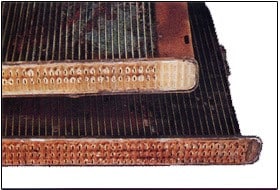
Solder Bloom
Solder corrosion caused by the degradation of rust and leak inhibitors in antifreeze. Tube to header joints are weakened and corrosion can restrict coolant flow.
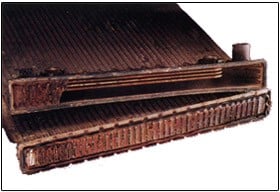
Internal Deposits
Rust and leak inhibitors can form solids that collect in the cooling system and restrict flow.
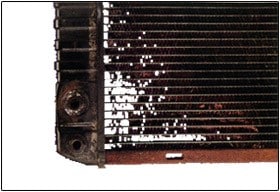
Fin Deterioration
A chemical deterioration of the fins most often caused by road salt or sea water.
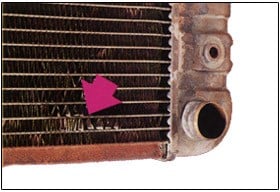
Fin Bond Failure
A loss of solder bond between fins and tubes. Fins are loose in core causing loss of heat transfer and reducing radiator strength.
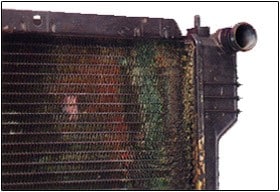
Tube To Header Leaks
Failure of the solder joint results in coolant loss.
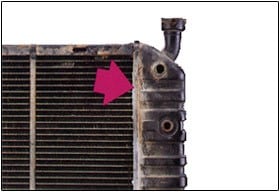
Leaky Tank To Header Seam
Solder joint failure or a cracked header is generally the result of pressure-cycle fatigue.
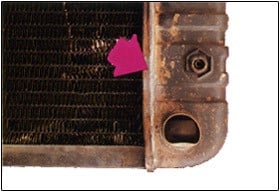
Blown Tank-To-Header Seam
An indication that the radiator has been subjected to extreme pressures resulting from exhaust leaking into the cooling system.
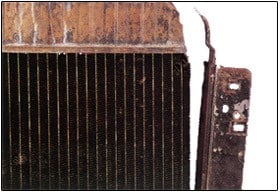
Loose Side Piece
Can lead to flexing of the core and radiator tube failure
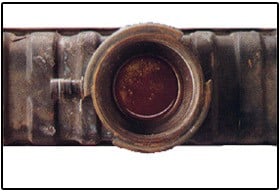
Blown Tank-To-Header Seam
Coolant shows traces of oil. Transmission or engine damage can result from the mixing of coolant with transmission fluid or engine oil.
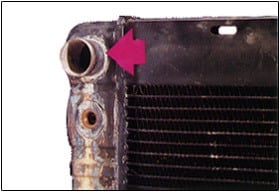
Blown Tank-To-Header Seam
Leaks in this area can be caused by fatigue or solder joint corrosion.
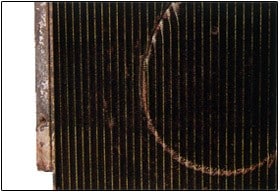
Fan Damage
A minor collision or a failed water pump can result in radiator damage
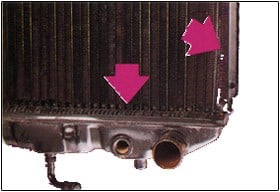
Over Pressurization
Excessive pressure in the radiator caused by a defective pressure cap or engine exhaust leak can destroy the radiator
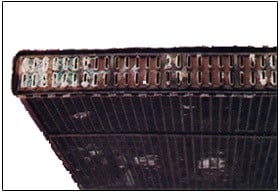
Electrolysis
Stray Electrical current can cause excessive corrosion of metal components
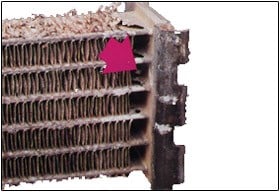
Electrolysis
Stray electrical current can cause an electrochemical reaction that will produce voids in tubes.
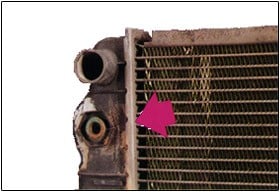
Cracked Plastic Tanks
High stress in the radiator can cause premature plastic-tank failure.
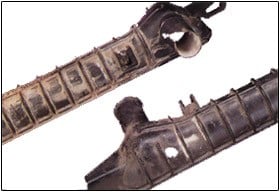
Steam Erosion
Steam can break down the plastic tank which will produce thinning and ultimately holes in the plastic tank. Frequently, white deposits are also found.
If you are having problems with your radiator, please call 780-465-2783 to make an appointment to have your vehicle serviced.
Ask for a Quote













